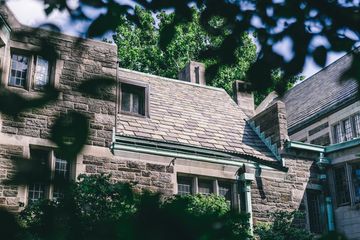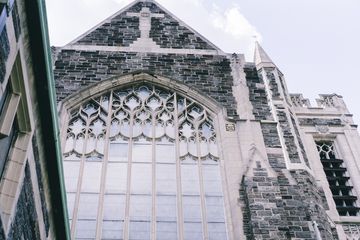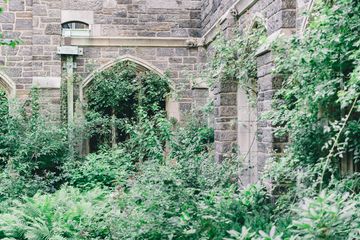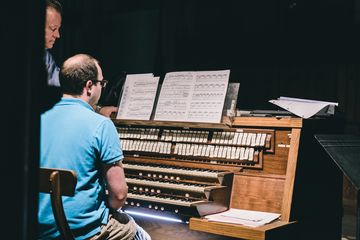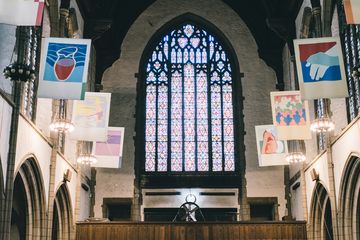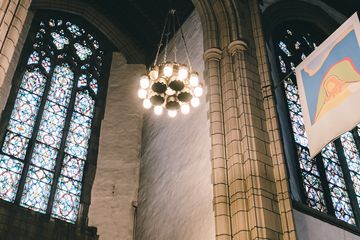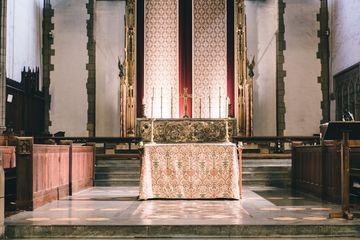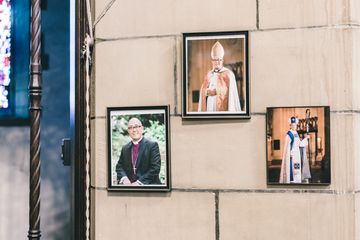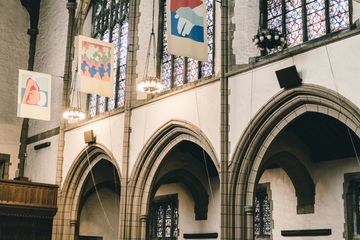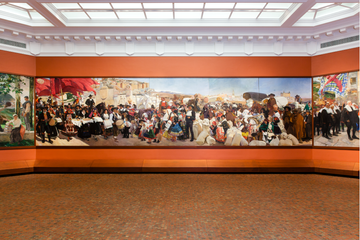Before I even stepped foot into the American Academy of Arts & Letters, my attention was caught by the elaborate sculptural bronze doors at the entrance. Created by Academy member Adolph Alexander Weinman and dedicated to fellow member Mary Wilkins Freeman, the doors represent literature, fine arts, and music. They are a fitting first sight for an institute that is devoted to honoring the greatest American artists, architects, composers, and writers and encouraging further great works. The first room that the Manhattan Sideways team entered was the Portrait Gallery, a breathtaking space lined from floor to ceiling with framed pictures of the hundreds of renowned members of the Academy. The photographs are arranged by date of induction, dating back to the Academy's inception in 1898. While walking around the impressive display, the Manhattan Sideways team and I spotted familiar faces, including Toni Morrison, Allen Ginsberg, Robert Frost, and E. B. White. Cody Upton, the Academy’s Executive Director, remarked that they will soon need to create more space to accommodate pictures of their newest inductees. Membership is capped at 250, and once selected, inductees are members for life. When we visited in 2017, playwright Sam Shephard had recently passed away, so there was a lot of discussion concerning who would replace him. Cody explained how the system works: Members send in nominations to the Academy, and vacancies are broken down by department, so those within the department in question get the first vote on the nominees. A similar process is undertaken to select the recipients of the seventy awards and prizes presented in the ceremonial held each May, which is also when the new members are inducted into the Academy. Not only is it a great honor to be selected, but according to Cody, it is amazing to be part of a process in which “very illustrious artists single out their peers. ”In discussing the passing of Sam Shephard, Cody revealed that one of the more fascinating and touching traditions of the Academy is to hold a memorial service, during which the family of the departed selects one of his or her peers to deliver a eulogy that “pays tribute to a deceased artist. ” These eulogies are some of the most significant works stored in the Academy library, Cody shared, since many of them showcase “the greatest writers writing about other writers. ”As we continued browsing through the pictures on the wall, we were curious to learn more about how the diversity and demographic of the members might have changed over the years. Cody clarified that although the Academy was once “kind of like a boys’ club, ” that is not the case anymore. Rather, the artists selected for membership “reflect the changing attitudes of America over the course of the twentieth century - progressively more liberal as time moved on. ” To illustrate, he pointed out the portrait of Julia Ward Howe, famed for writing the "Battle Hymn of the Republic, " who was the first woman to join the Academy's ranks in 1907. Nevertheless, no further women were selected until the induction of Edith Wharton and Mary Wilkins Freeman in 1926 - a significant gap that alludes to the conservative beginnings of the Academy. One can compare that to the new members in 2016: Out of seventeen total inductees, twelve were women. Cody directed our attention to the stained-glass windows outside of the Portrait Gallery. The windows belonged to Arabella Huntington but were donated to the Academy by her son, Archer Huntington, who was also responsible for deeding the Academy its location on 155th Street, where it has remained since 1923. The heir of a railroad magnate as well as a notable poet and Hispanophile, Archer Huntington used his wealth to cultivate culture in the city. Specifically, he purchased the entirety of the property now known as Audubon Terrace and apportioned it to organizations such as the Hispanic Society of America and the American Academy of Arts and Letters in order to preserve vital works of art and literature. He also donated several pieces of furniture and rugs from his personal collection that are still on display in the building today. "[Huntington] bankrolled us, and we are still using the money that he gave to us in the 1930s, " Cody explained. Other members have followed Huntington's example - “Much of the artwork throughout the space is either by our members or given to us by our members. ” The same is true of the expansive library on the upper floor of the building, which solely contains volumes written for or about the Academy members. As extraordinary as the main building is, we were just as enthusiastic to explore the auditorium, constructed in 1930 as an attachment to the original structure. It is a stunning space, with the classic ambiance of an old-world theater, complete with red velvet drapes and chairs and a high arched ceiling. It has some of the best acoustics in the city, Cody informed us. Those that are fortunate enough to be "in the know" take advantage of the unparalleled acoustics when preparing live recordings of their music. “Only a few musical or theatrical companies know about it, but more people should, ” he added. Needless to say, this was the most fitting conclusion to my journey, walking from 1st Street to 155th and from the East River to the Hudson. As the owner of a children's bookstore and the daughter of a renowned author, discovering this hidden gem in Manhattan was a perfect last stop.

